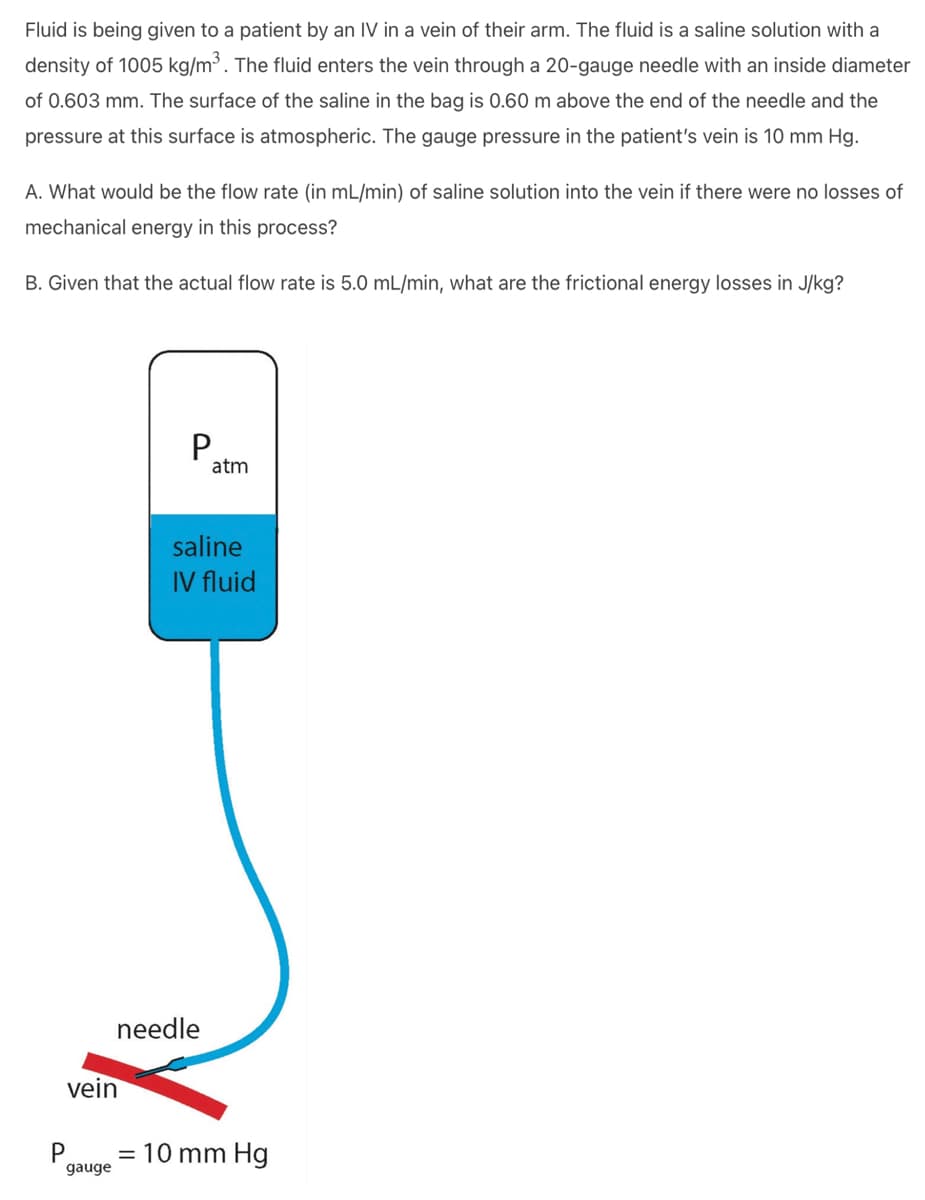Fluid is being given to a patient by an IV in a vein of their arm. The fluid is a saline solution with a density of 1005 kg/m³. The fluid enters the vein through a 20-gauge needle with an inside diameter of 0.603 mm. The surface of the saline in the bag is 0.60 m above the end of the needle and the pressure at this surface is atmospheric. The gauge pressure in the patient's vein is 10 mm Hg. A. What would be the flow rate (in mL/min) of saline solution into the vein if there were no losses of mechanical energy in this process? B. Given that the actual flow rate is 5.0 mL/min, what are the frictional energy losses in J/kg? vein gauge P needle atm saline IV fluid = 10 mm Hg
Fluid is being given to a patient by an IV in a vein of their arm. The fluid is a saline solution with a density of 1005 kg/m³. The fluid enters the vein through a 20-gauge needle with an inside diameter of 0.603 mm. The surface of the saline in the bag is 0.60 m above the end of the needle and the pressure at this surface is atmospheric. The gauge pressure in the patient's vein is 10 mm Hg. A. What would be the flow rate (in mL/min) of saline solution into the vein if there were no losses of mechanical energy in this process? B. Given that the actual flow rate is 5.0 mL/min, what are the frictional energy losses in J/kg? vein gauge P needle atm saline IV fluid = 10 mm Hg
Chapter2: Loads On Structures
Section: Chapter Questions
Problem 1P
Related questions
Question

Transcribed Image Text:Fluid is being given to a patient by an IV in a vein of their arm. The fluid is a saline solution with a
density of 1005 kg/m³. The fluid enters the vein through a 20-gauge needle with an inside diameter
of 0.603 mm. The surface of the saline in the bag is 0.60 m above the end of the needle and the
pressure at this surface is atmospheric. The gauge pressure in the patient's vein is 10 mm Hg.
A. What would be the flow rate (in mL/min) of saline solution into the vein if there were no losses of
mechanical energy in this process?
B. Given that the actual flow rate is 5.0 mL/min, what are the frictional energy losses in J/kg?
vein
gauge
P
needle
atm
saline
IV fluid
= 10 mm Hg
Expert Solution
This question has been solved!
Explore an expertly crafted, step-by-step solution for a thorough understanding of key concepts.
Step by step
Solved in 2 steps with 2 images

Knowledge Booster
Learn more about
Need a deep-dive on the concept behind this application? Look no further. Learn more about this topic, civil-engineering and related others by exploring similar questions and additional content below.Recommended textbooks for you


Structural Analysis (10th Edition)
Civil Engineering
ISBN:
9780134610672
Author:
Russell C. Hibbeler
Publisher:
PEARSON

Principles of Foundation Engineering (MindTap Cou…
Civil Engineering
ISBN:
9781337705028
Author:
Braja M. Das, Nagaratnam Sivakugan
Publisher:
Cengage Learning


Structural Analysis (10th Edition)
Civil Engineering
ISBN:
9780134610672
Author:
Russell C. Hibbeler
Publisher:
PEARSON

Principles of Foundation Engineering (MindTap Cou…
Civil Engineering
ISBN:
9781337705028
Author:
Braja M. Das, Nagaratnam Sivakugan
Publisher:
Cengage Learning

Fundamentals of Structural Analysis
Civil Engineering
ISBN:
9780073398006
Author:
Kenneth M. Leet Emeritus, Chia-Ming Uang, Joel Lanning
Publisher:
McGraw-Hill Education


Traffic and Highway Engineering
Civil Engineering
ISBN:
9781305156241
Author:
Garber, Nicholas J.
Publisher:
Cengage Learning